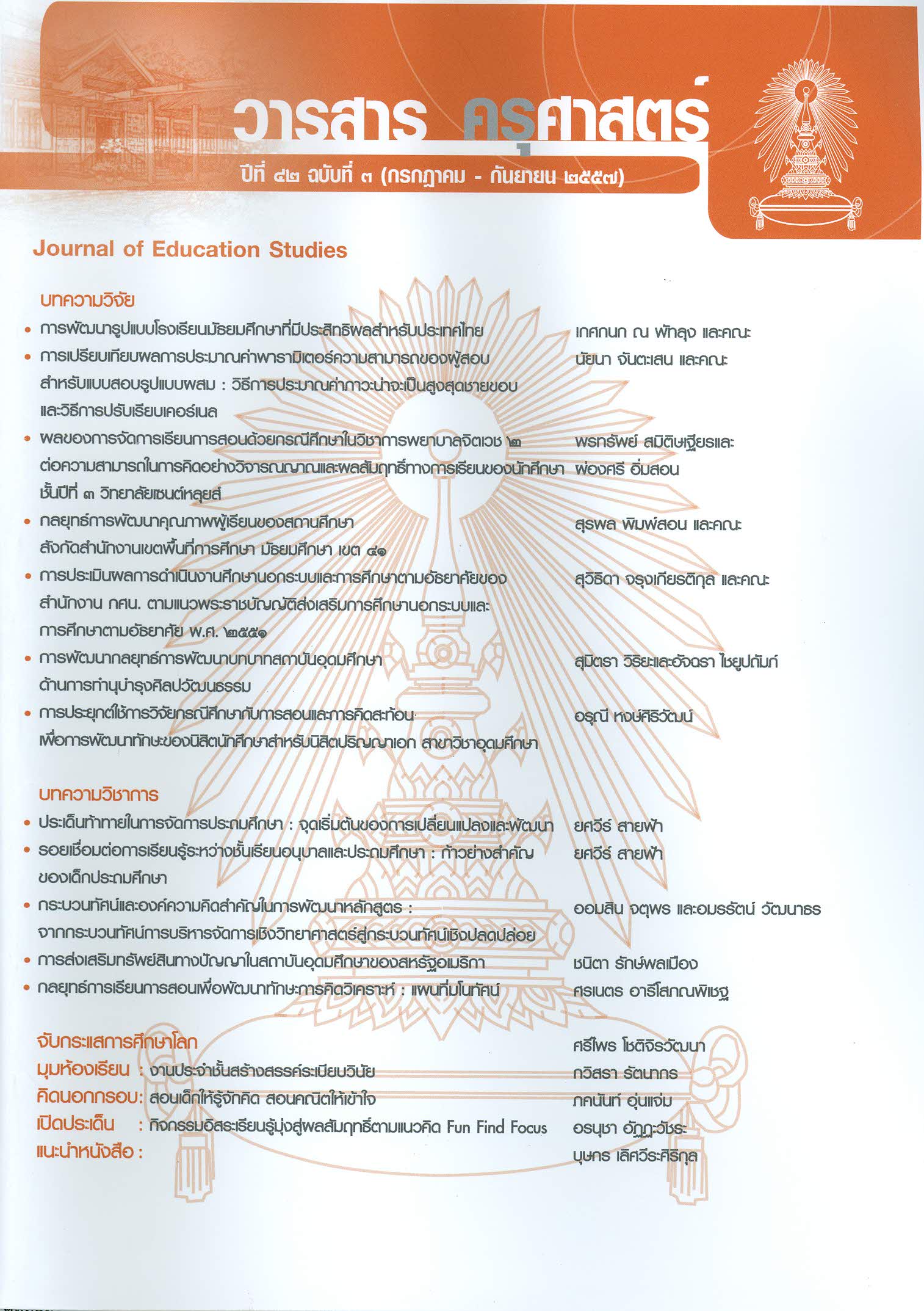การพัฒนากลยุทธ์การพัฒนาบทบาทสถาบันอุดมศึกษา ด้านการทำนุบำรุงศิลปวัฒนธรรม
Keywords:
การทำนุบำรุงศิลปวัฒนธรรม, บทบาทสถาบันอุดมศึกษา, กลยุทธ์, PRESERVATION OF ARTS AND CULTURE, ROLE OF HIGHER INSTITUTIONS, STRATEGIESAbstract
การวิจัยนี้มีวัตถุประสงค์เพื่อ 1) ศึกษาสภาพปัจจุบัน ปัญหาและบทบาทของสถาบันอุดมศึกษา ด้านการทำนุบำรุงศิลปวัฒนธรรม 2) วิเคราะห์ปัจจัยแวดล้อมที่เอื้ออำนวยต่อประสิทธิผลการดำเนินงาน ด้านการทำนุบำรุงศิลปวัฒนธรรม และ3)กำหนดกลยุทธ์การพัฒนาบทบาทของสถาบันอุดมศึกษาด้านการ ทำนุบำรุงศิลปวัฒนธรรม กลุ่มตัวอย่างเป็นผู้ทรงคุณวุฒิและผู้เชี่ยวชาญด้านทำนุบำรุงศิลปวัฒนธรรม 12 คน ผู้ปฏิบัติงาน 240 คน เครื่องมือการวิจัย ได้แก่ สัมภาษณ์แบบกึ่งโครงสร้างเกี่ยวกับสภาพปัจจุบัน ข้อคิดเห็นในการดำเนินการและการพัฒนาบทบาทด้านการทำนุบำรุงศิลปวัฒนธรรมของสถาบันอุดมศึกษา และแบบสอบถามความคิดเห็นของผู้ปฏิบัติงานด้านการทำนุบำรุงศิลปวัฒนธรรม วิเคราะห์ข้อมูลด้วย การวิเคราะห์เนื้อหา ความถี่ ร้อยละ ค่าเฉลี่ย ส่วนเบี่ยงเบนมาตรฐาน ทดสอบค่าที (t-test) และการ วิเคราะห์องค์ประกอบ (Factor Analysis)
ผลการวิจัยพบว่า 1) สภาพปัจจุบันองค์กรด้านการทำนุบำรุงศิลปวัฒนธรรมของสถาบันอุดมศึกษา เป็นศูนย์ที่มหาวิทยาลัยจัดตั้ง เพื่อเป็นห้องปฏิบัติงานด้านวิถีชีวิตชุมชน ปัญหาที่พบ คือ ขาดความสนใจจาก ผู้นำรัฐบาล ขาดบุคลากร ขาดงบประมาณ ส่วนบทบาทของสถาบันอุดมศึกษาต้องสอดคล้องกับนโยบาย ระดับชาติ และเป็นภารกิจที่สำคัญเท่าเทียมกับด้านอื่นๆ 2) ปัจจัยแวดล้อมที่เอื้ออำนวยต่อประสิทธิผลการ ดำเนินงานด้านการทำนุบำรุงศิลปวัฒนธรรมทั้ง 36 ปัจจัย ส่งผลต่องานในระดับปานกลาง ( x 3.35 , S.D. 1.207) ถึงระดับมาก ( x 4.43, S.D. 1.207) ด้านนโยบายส่งผลมากที่สุด รองลงมาเป็นด้านบุคลากร และวิเคราะห์องค์ประกอบได้ 10 องค์ประกอบที่อธิบายความแปรปรวนร่วม (Eigenvalues) ได้ร้อยละ 89.107 3) กลยุทธ์การพัฒนาบทบาทของสถาบันอุดมศึกษาด้านการทำนุบำรุงศิลปวัฒนธรรม จำนวน 13 กลยุทธ์ 4 ด้าน คือ 1) ด้านนโยบาย 2) ด้านบุคลากร 3) ด้านการพัฒนา 4) ด้านการนำกลยุทธ์ลงสู่ การปฏิบัติ
The objectives of this research were: 1) to study current circumstances, issues and roles of higher education institutions concerning arts and cultural preservation, 2) as well as the factors contributing to its eff iciency; and, 3) to develop strategies for the role development of higher education institutions in arts and cultural preservation. The sample group comprised 12 qualif ied individuals and experts in the f ield of arts and cultural preservation and 240 staff. Research tools were semi-structured interviews on current circumstances and opinions on the roles of higher education institutions in arts and cultural preservation, as well as questionnaires for the personnel engaged in the arts and cultural initiatives. The data is analyzed for content, frequency, percentage, average, standard deviation, t-test and factor.
The research has found that 1) most arts and cultural preservation entities of higher education institutions are arts and cultural centers established by the universities. Their goals a manner as that of a laboratory, with the content presented being the way of life in a community. The most common problems found are the lack of attention from government leaders, the lack of personnel. Their role is consistent with national policies on promotion and implementation of activities in this area. 2) The signif icance of arts and cultural preservation mission is comparable with other missions of higher education institutions. All 36 factors studied are found to have moderate ( x 3.35 , S.D. 1.207) to high ( x 4.43, S.D. 1.207) impacts on arts and cultural preservation initiatives with policy having the most impact, followed by personnel. A total of ten components are determined with eigenvalues of 89.107. 3) The thirteen strategies for the role development of higher education institutions in arts and cultural preservation involve four areas of operation: policy, personnel, development and implementation.




